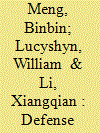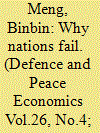|
|
|
Sort Order |
|
|
|
Items / Page
|
|
|
|
|
|
|
| Srl | Item |
| 1 |
ID:
137933


|
|
|
|
|
| Summary/Abstract |
There are conflicting views as to the relationship between a nation’s defense expenditure (DE) and its population’s income inequality (INEQ). DE, always an important part of government budget, can easily crowd out transfer payments, necessary to improve INEQ; however, these payments may also create a demand that may raise the income levels of the lower income earners. Consequently, the relationship between DE and INEQ is an important question. This paper examines the relationship between DE and INEQ in China for the period of 1989–2012. Utilizing basic cointegration and causality tests, our objective is to add to the literature by providing evidence that China’s DE, in fact, do have an impact on INEQ.
|
|
|
|
|
|
|
|
|
|
|
|
|
|
|
|
| 2 |
ID:
139211


|
|
|
|
|
| Summary/Abstract |
Both the increasing defense spending and the widening divergence between rich and poor countries are of great concerns. This paper attempts to explain the two concepts in a unify theory framework. In the view of conflict economics, a nation’s defense spending can be seen as the fighting commitment of distributive effort in the global economy while other is the productive effort. The development of global economy needs the productive efforts from almost every nation, and the distribution of the aggregate output is determined in large degree by the fighting commitment of each nation. The numerical simulation of the model gives a reasonable explanation of the patterns of the divergence/convergence of prosperity-poverty gap between nations, the fact which is evidenced by many empirical analyses. (1) Given the initial wealth ratio between nations fixed, there is a critical value of fighting decisiveness, when the actual value is larger than the critical value, it is more likely to result in Matthew effect; otherwise the gap would gradually be shortened. (2) Given the fighting decisiveness fixed, there is a critical value of initial wealth ratio, when the actual value is larger than the critical value, it is more likely to result in Matthew effect; otherwise, the gap would gradually be shortened. The study gives a new perspective to explain and handle the increasingly defense spending and the prosperity-poverty gap between nations.
|
|
|
|
|
|
|
|
|
|
|
|
|
|
|
|
|
|
|
|
|